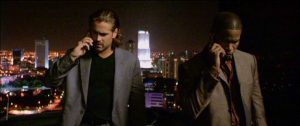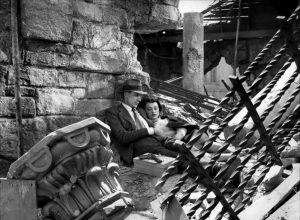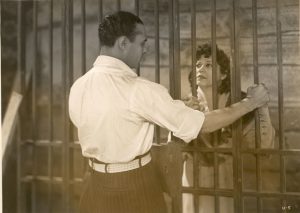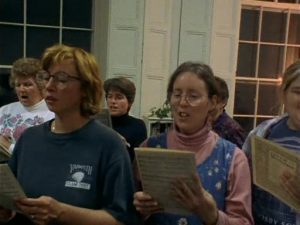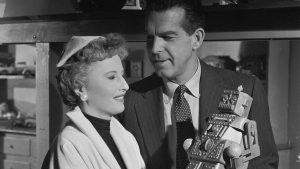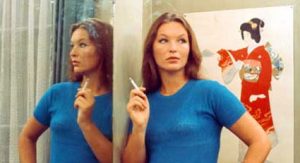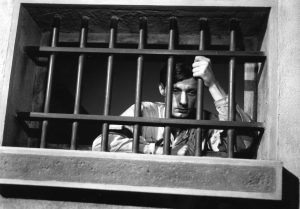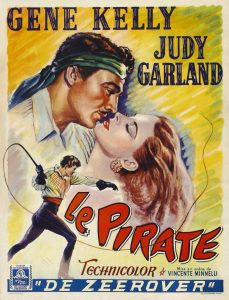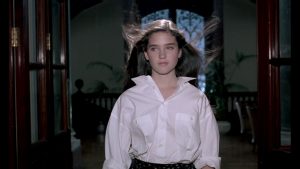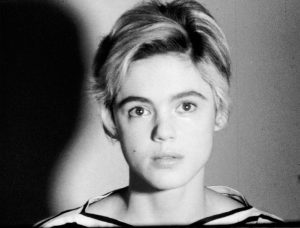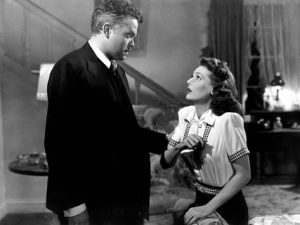MIAMI VICE
Michael Mann (U.S. 2006) 134 min. DCP. With Jamie Foxx, Colin Farrell, Gong Li.
The subject last year of a major retrospective at the Brooklyn Academy of Music’s BAMcinématek, Michael Mann is an auteur touted by BAM and others as “a master of the modern urban noir, with a unique brand of pulp poetry that is pure cinephiliac pleasure.” He’s also the director chosen in the past several years to begin the Monday night film series presented for Professor Ken Eisenstein’s “Introduction to Film Studies” course. This year the Mann selection is Miami Vice, a 21st century updating of the director’s hit 1980s television series. Jamie Foxx and Colin Farrell, as Tubbs and Crockett, go undercover to infiltrate a drug cartel, jetting between Haiti, Cuba and Paraguay, their exploits stylishly imagined in “day-glo, digital nightscapes… one of the purest distillations of Mann’s visionary aesthetic” (BAMcinématek).
CLOAK AND DAGGER
Fritz Lang (U.S. 1946) 104 min. 35MM. With Gary Cooper, Robert Aida, Lilli Palmer.
German émigré Fritz Lang’s anti-Nazi espionage thriller is set during WWII and presages the nuclear threat of the Cold War era. Gary Cooper’s college professor, recruited by the US Office of Strategic Services for his training in nuclear physics, goes undercover in Europe and finds his rationalism upended by a hostile war-town world. Adapted from a nonfiction exposé of the famed O.S.S. spy outfit, Cloak and Dagger may seem more optimistic than your typical Lang, though the director later complained that Warner Bros. cut his preferred ending, of Cooper uncovering an abandoned Nazi bomb factory. 35mm restored print courtesy of the UCLA Film & Television Archive. Restoration funding provided by The Film Foundation.
Monday, September 4 at 7pm
UNDERWORLD
Oscar Micheaux (U.S. 1937) 95 min. With Bee Freeman, Sol Johnson, Slick Chester.
Upon graduating from college in the South, light-skinned Paul Bronson (Johnson) is lured to Southside Chicago. Though it was one of the most sophisticated black urban neighborhoods in the world at the time, Micheaux presents the environment as sordid, a swirling underworld in which Paul finds himself ensnared when he falls for a local mob boss’ mistress. Familiar Micheaux tropes (production numbers, an idiosyncratic montage sequence) and concerns (particularly class antagonism) give this gangster film a unique focus; as Micheaux scholar J. Ronald Green describes it, “At stake in this story is the future of the race, the best hope of which is embodied in [its] two college graduates.”
BELFAST, MAINE
Frederick Wiseman (U.S. 1999) 248 min.
A film about ordinary experience in a beautiful old New England port city, Belfast, Maine is a portrait of the daily life, work (of lobstermen, tug-boat operators, factory workers, shop owners, city counselors, doctors, judges, policemen, teachers, social workers, nurses and ministers) and cultural activity (choir rehearsal, dance class, music lessons and theatre production) that comprise a community. It is “extraordinary in two ways. First, it is an immensely rich and immeasurably valuable microcosm of American life at the end of the twentieth century. Second, and most unexpected, it is a microcosm of Wiseman’s art… It reminds us, movingly, of the persistent strength and beauty of the natural world, which is made to serve the economy; and it pays tribute to the courage and good will of people who go out, day after day, to ease what suffering they can” (Stuart Klawans, The Nation).
THERE’S ALWAYS TOMORROW
Douglas Sirk (U.S. 1956) 84 min. 35MM. With Fred MacMurray, Barbara Stanwyck, Joan Bennett, Pat Crowley.
As the film begins, in the rain, a title card announces, “Once upon a time, in sunny California…” There lives toy manufacturer Fred MacMurray, with his perfect fairy tale family. Home alone one evening, he answers the doorbell, rung by an acquaintance from twenty years ago: a glamorous Stanwyck, carrying memories and a carefully hidden torch. While MacMurray simultaneously asserts his current happiness and indulges in fantasies of youth regained, Stanwyck conveys the ambivalence of an ethical but lonely person who wants what she can’t have. Sirk’s brilliance is in recognizing both the horror and the wisdom of accepting one’s lot; when MacMurray finally claims “I’m all right now,” it’s either one of the most devastating lies in all of cinema or, even worse, maybe true. Adapted from Juliet Clark’s Pacific Film Archive notes.
TOP OF PAGE
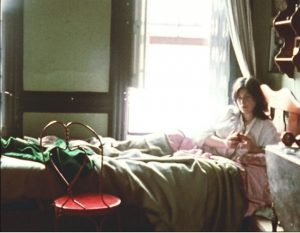
Monday, September 25 at 7pm
LA CHAMBRE
Chantal Akerman (Belgium/U.S. 1972) 11 min. DCP.
HOTEL MONTEREY
Chantal Akerman (Belgium 1972) 62 min. DCP.
This program of two early works by the great Chantal Akerman pairs a short formal experiment with a longer study of a cheap Manhattan hotel. In La Chambre, the first film the director made in New York (where she was exposed to films by Michael Snow, Yvonne Rainer, Marcel Hanoun and Jonas Mekas), we see the furniture and clutter of a small apartment room become the subject of a moving still life—with Akerman herself staring back at us. Hotel Monterey, the director’s first sustained engagement with the boundaries of cinematic space and time, glows with mystery and unexpected beauty, its corridors, elevators, rooms, windows and occasional occupants framed like Edward Hopper tableaux.
“Like Orson Welles, the Belgian director Chantal Akerman revolutionized the cinema with a movie that she made in her mid-twenties –Jeanne Dielman, from 1975 – and then made even more artistically advanced films that never achieved the same level of fame. Her career is a titanic project of personal cinema that redefined the art of filming oneself – of a woman filming herself – yet most of her films remain rare.” – Richard Brody, The New Yorker
TOP OF PAGE
Monday, October 2 at 7pm
TWO OR THREE THINGS I KNOW ABOUT HER
Jean-Luc Godard (France 1967) 87 min. 35MM. With Marina Vlady, Roger Montsoret, Jean Narboni. French with English subtitles.
Among the legendary French filmmaker’s finest achievements, Two or Three Things takes as its ostensible subject the daily life of a suburban housewife who prostitutes herself for extra money. Yet this is only a template from which Godard spins off into provocative philosophical tangents, envisioned by Raoul Coutard in ravishing wide-screen color. In what may be his most revelatory look at consumer culture, Godard, ever the provocateur, whispers in our ears about money, sex, fashion, the city, love, language, war: in a word, everything.
“Amid splashes of bold color, discordant sound and brilliant observation, the personal meets the political.” – Manohla Dargis, The New York Times
TOP OF PAGE
Monday, October 16 at 7pm
A MAN ESCAPED
Robert Bresson (France 1956) 101 min. 35MM. With François Leterrier, Charles Le Clainche, Maurice Beerblock. French with English subtitles.
With the simplest of concepts and sparest of techniques, Robert Bresson made one of the most suspenseful jailbreak films of all time in A Man Escaped. Based on the account of an imprisoned French Resistance leader, this unbelievably taut and methodical marvel follows the fictional Fontaine’s single-minded pursuit of freedom, detailing the planning and execution of his escape with gripping precision. But Bresson’s film is not merely about process — it’s also a work of intense spirituality and humanity.
Monday, October 23 at 7pm
THE PIRATE
Vincente Minnelli (U.S. 1948) 102 min. 35MM. With Judy Garland, Gene Kelly, Walter Slezak, Gladys Cooper.
Vincente Minnelli’s high-spirited musical send-up of the swashbuckler genre stars Gene Kelly as a traveling vaudevillian who poses as a notorious brigand to catch the eye of sheltered maiden Judy Garland. With its fantastical Caribbean settings and witty Cole Porter songs, the film is as the director described it: “highly colored, theatrical as possible, flamboyant, swirling, and larger than life.” (Pacific Film Archive notes)
TOP OF PAGE
Monday, October 30 at 7pm
PHENOMENA AKA CREEPERS – Remastered English/Italian Version!
Dario Argento (Italy 1985) 116 min. With Jennifer Connelly, Donald Pleasence, Daria Nicolodi. Italian and English with English subtitles.
Horror maestro Dario Argento’s 1986 classic stars a very young Jennifer Connelly, playing a an American girl at a Swiss boarding school who uses her telepathic empathy with insects to solve a series of bloody murders. Argento fans consider this one of the director’s strangest films, and many of them also name it as their favorite; it’s a crazy blend of Giallo (the Italian thriller genre so influential for filmmakers such as Brian De Palma, Quentin Tarantino and Darren Aronofsky) and supernatural horror – perfect for the night before All Hallows’ Eve.
TOP OF PAGE
Monday, November 6 at 7pm
FACE & SCREEN TESTS – Restoration!
Andy Warhol (U.S. 1965 + et al.) TRT approx. 106 min. 16MM. With Edie Sedgwick, Susan Sontag and others.
Restored by the Museum of Modern Art and the Warhol Museum and long unseen, Face is an hour-long close-up portrait of Warhol’s charismatic superstar-model Edie Sedgwick. This recently rediscovered film plays alongside ten of the almost five hundred iconic Screen Tests that Warhol made between 1964 and 1966. For these “tests,” famous and instructed to sit still for three minutes. During the ‘60s, these likenesses-cum-performances – of Salvador Dalí, Dennis Hopper and Lou Reed among other notables – were often shown at The Factory, but rarely in public. They’ve since become the stuff of legend.
TOP OF PAGE
Monday, November 13 at 7pm
THE STRANGER
Orson Welles (U.S. 1946) 95 min. 35MM. With Edward G. Robinson, Loretta Young, Orson Welles.
Welles’ most successful film at the box office was this thriller about an escaped Nazi war criminal hiding in Connecticut, where he lives with his unsuspecting all-American bride (Young). The director himself took the title role; as the heinous mastermind of the Final Solution, Welles auditions “the doom-laden eloquence of his later villain Harry Lime (from The Third Man) and winds up with a chilling example of the kind of sophistication that can easily fool the American middle-class into naïve complacency” (Harvard Film Archive).
FEAR – Restoration!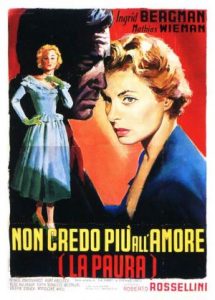
Roberto Rossellini (Germany/Italy 1954) 84 min. DCP. With Ingrid Bergman, Mathias Wieman, Kurt Kreuger. English version.
Rossellini’s last film with (then wife) Ingrid Bergman is about a woman whose infidelity embroils her in a blackmail scheme. Set in contemporary Germany and filmed in Munich in 1954, Fear’s drama takes place in an economically recovering West Germany, a country haunted by and repressing its guilt – rebuilding materially while struggling with its moral reconstruction. At the same time, “it is difficult to resist the temptation to see, in the scientist who subjects his wife to his experiments, the director’s double because he subjected his wife, the actress, to experiments at the same time. He had been doing this since Stromboli, experimenting with a new language, without shying away from the certainty of destroying the diva in her, and showing her as a woman” (Elena Dagrada). Digital restoration by Fondazione Cineteca di Bologna, Cineteca Nazionale and Istituto Luce Cinecittà as part of the Rossellini Project.
LA BÊTE HUMAINE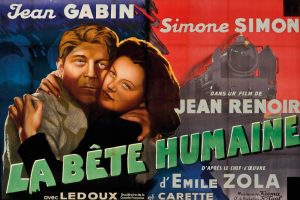
Jean Renoir (France 1938) 100 min. 35MM. With With Jean Gabin, Simone Simon, Fernand Ledoux. French with English subtitles.
Based on the classic Emile Zola novel, Jean Renoir’s La bête humaine was one of the legendary director’s greatest popular successes—and earned star Jean Gabin a permanent place in the hearts of his countrymen. Part poetic realism, part film noir, the film is a hard-boiled and suspenseful journey into the tormented psyche of a workingman.
